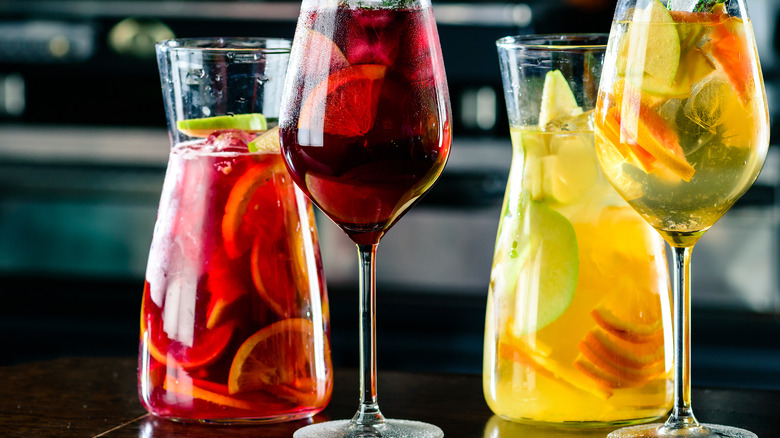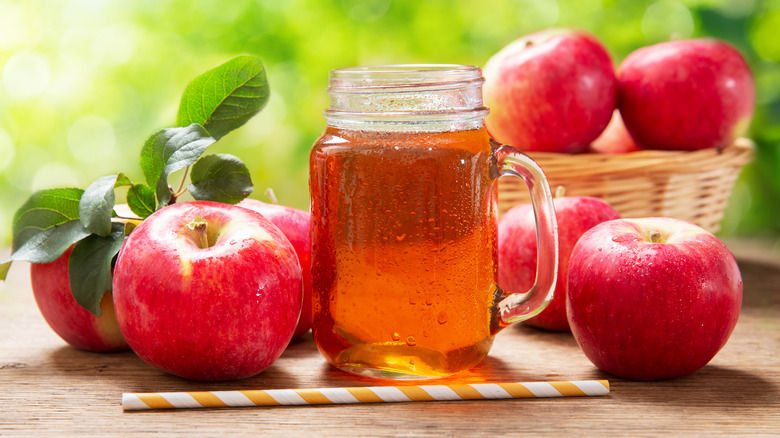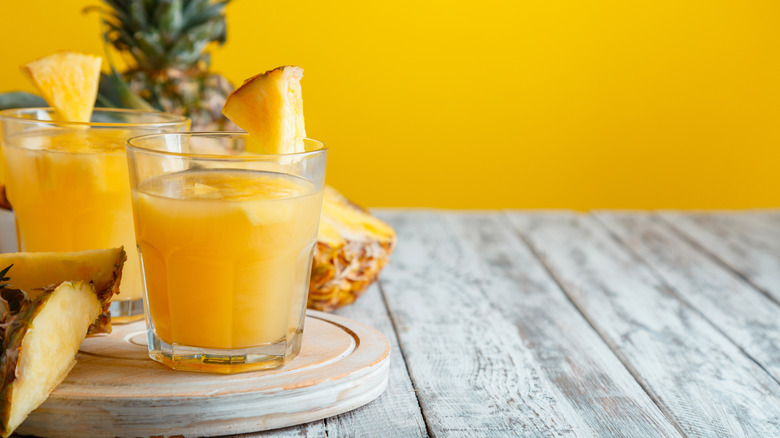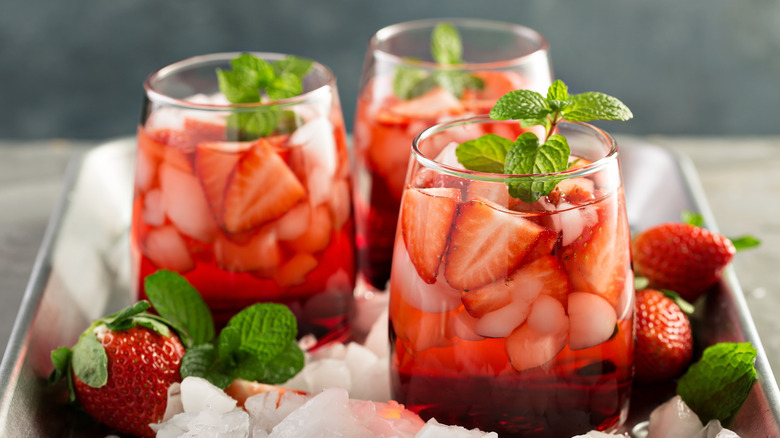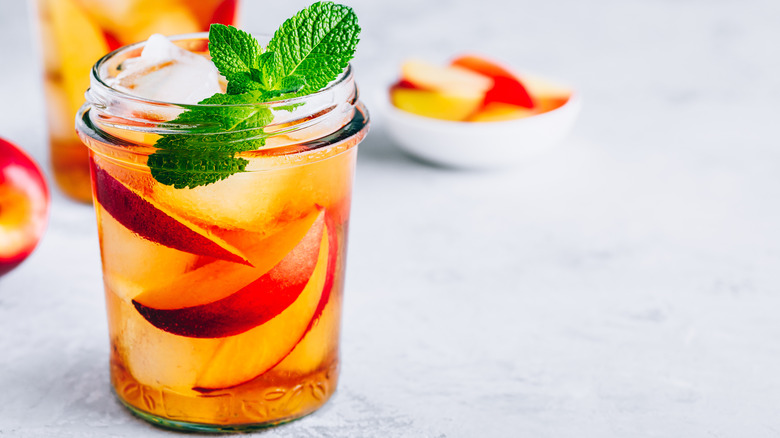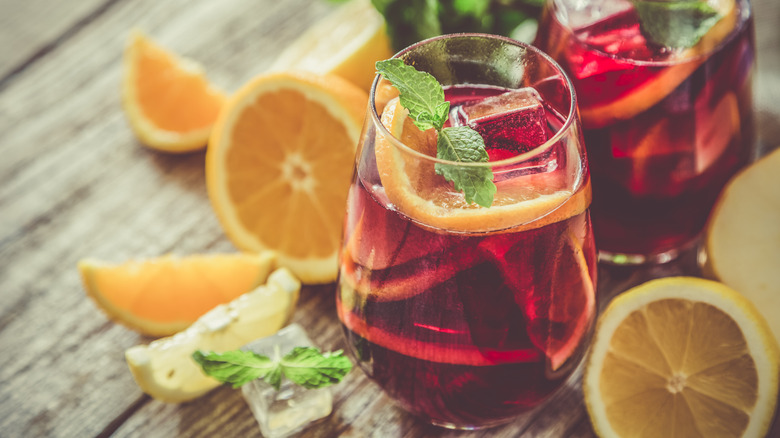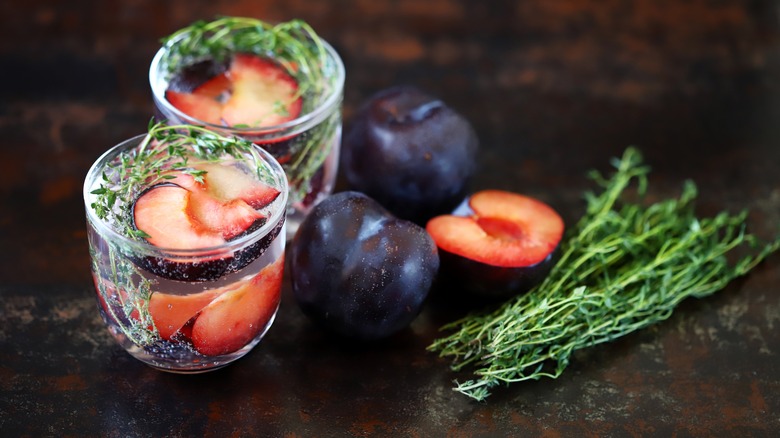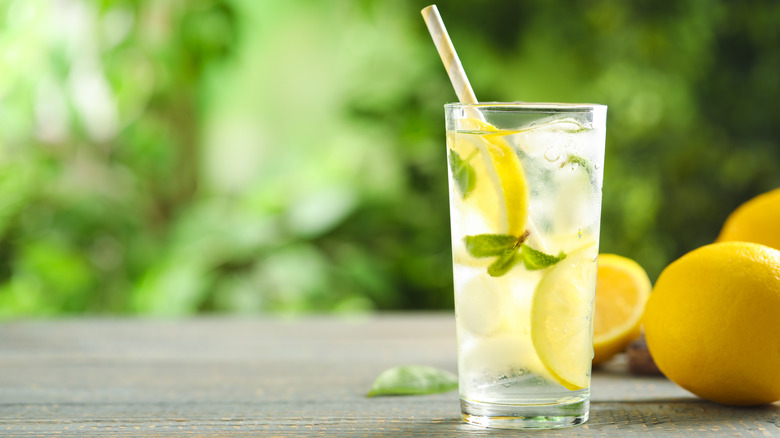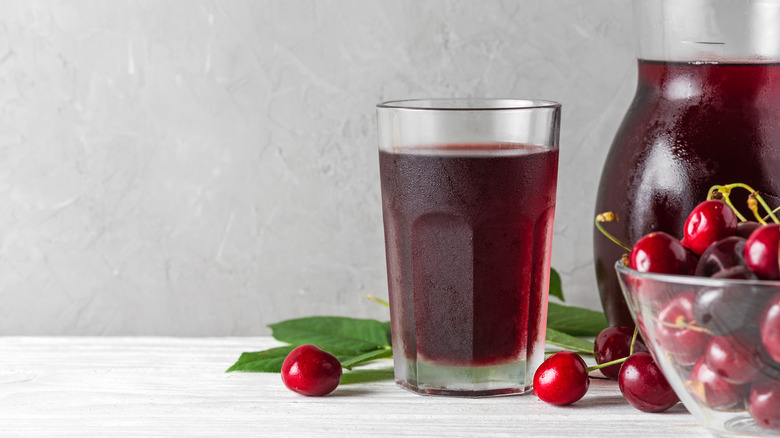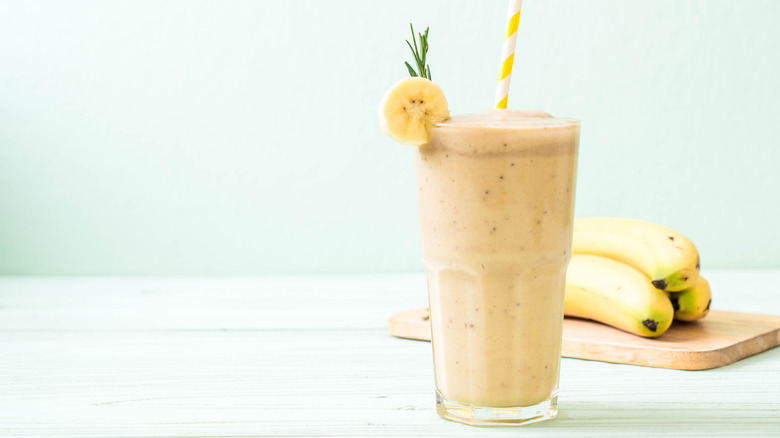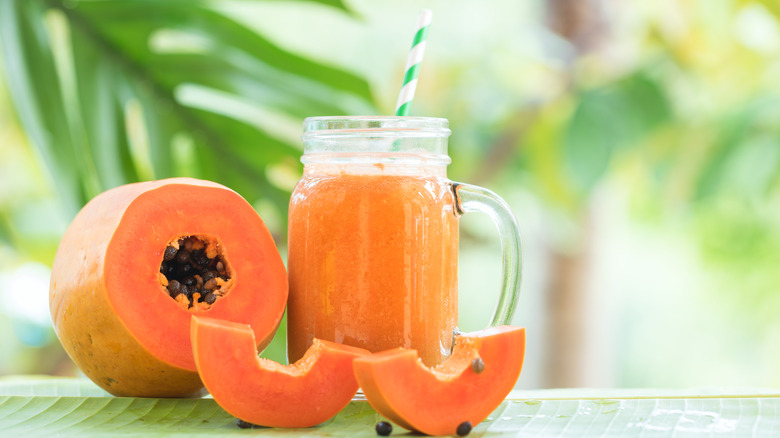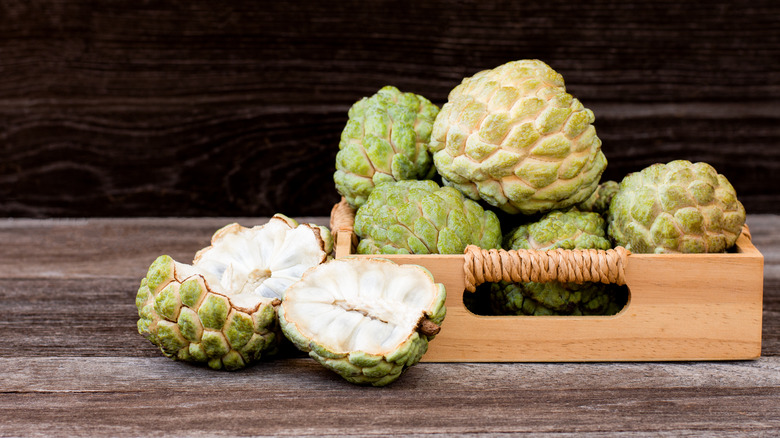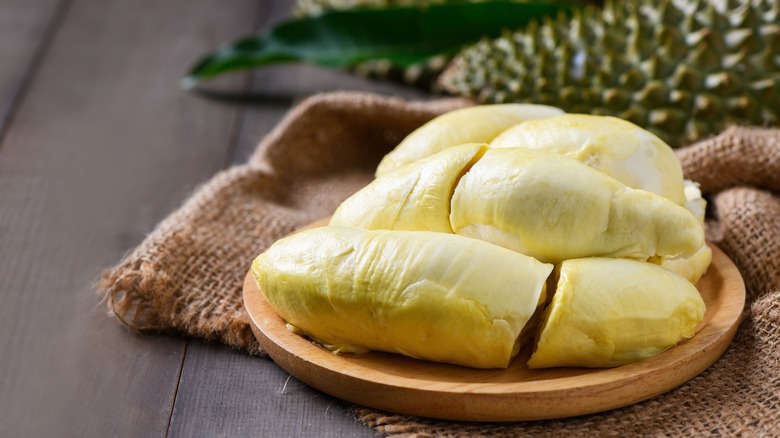8 Fruits You Should And 4 Fruits You Shouldn't Use In Sangria
Sangria is one of those beverages that conjures images of camaraderie, community, and jovial gatherings. Whether you're thinking of a group of college friends glistening with sweat around a table at a curbside cafe in summer, family picnics in the garden filled with raucous laughter, or girlfriends clinking glasses during Sunday brunch, sangria is there. Regardless of the exact scenario in which you drink it, its history may not necessarily be top of mind, though its past is quite simple.
According to Spanish Sabores, food historians date sangria back to the 1800s. It was introduced to the US in 1964, when it was presented by the Pavilion of Spain at the New York World's Fair. But it goes farther back. Ancient Romans reportedly mixed subpar wine into potentially bacteria-laden water, adding herbs and spices to make it all taste better. Today, while Americans may order sangria whenever they please, modern day Spaniards mostly reserve it for gatherings in the home. It's so popular that December 20 is even National Sangria Day. Consider celebrating by making your own sangria and hosting a tasting parties. But how should you go about assembling your own sangria? Read on to learn more about some of the best and worst fruits to use for the task.
Use: Apples
As it turns out, apples are quite the party starter in the world of sangria. This fruit pairs well with a wide variety of flavors. You've likely had it with nuts like almonds and hazelnuts, other fruit such as mango and citrus, or even with hardy and fragrant herbs like rosemary. Beside the wine used in sangria, apple is also commonly paired with brandies, rums, and vermouths. Plus, there is plenty of room to play around here if you're feeling extra creative. Given its versatility, you can easily explore how some of the most popular types of apples can affect the taste of your sangria.
But what, exactly, should you do? Start with some grocery store basics, like the Granny Smith. Even though Granny Smith apples are decidedly tart, the upside of that acidity is you get to incorporate as much sweetness as you'd like into your drink. Meanwhile, golden delicious apples do well with warmth-inducing spices like cinnamon and nutmeg that are perfect for an autumnal sangria. Other varieties like honeycrisp, Fuji, and cosmic apples boast versatility, tart sweetness, and a delightfully crunchy texture. If you want to be really extra about making apples the star of your sangria, you can even brew a little apple wine and incorporate that into your special mix.
Use: Pineapples
Although pineapples can be a little aggressive, as many will have learned after overindulging in this acidic fruit, they are frankly worth every single sting lodged inside the fruit. Pineapple also comes with interesting botanical traits that you can use to impress your friends next time you're all gathered around a pitcher of sangria. For starters, per WebMD, pineapples are actually made up of a bunch of fruitlets that are attached to the inner core. Meanwhile, though the US previously got most of its pineapple supply from Hawaii, today it's mostly sourced from outside the country in places like Brazil, Costa Rica and the Philippines.
Pineapple is also just good for you. According to Healthline, pineapples boast impressive antioxidant properties that not only improve heart health, but may reduce your risk of developing cancer. The bromelain inside a slice of pineapple also supports immune functioning by suppressing inflammation, while the fruit recharges your carbs, meaning better and faster exercise recovery. Why not get all of those benefits and seriously delicious flavor straight from your party cup? Just make sure you store it at room temperature for a day or two before you incorporate it into the sangria mix, as this will give you a much juicier fruit that breaks down more easily.
Use: Strawberries
If you're looking for some seriously accessible sangria fruit, look no further. Per Country Living, strawberries are cultivated in every state in the United States, not to mention in every province in Canada. Want some more strawberry facts to enrapture your sangria-sipping buddies? Each strawberry holds roughly 200 seeds and, if you're looking to get extra pedantic, they don't qualify as berries because they have no seed-producing body inside of the fruit. What they do qualify for though, is a place within the rose family, hence the wonderful scent you can enjoy while they are blooming.
Additionally, ancient Romans believed that strawberries possessed medicinal properties. According to Healthline, they could have been onto something. Not only do strawberries look pretty, but it turns out that they are full of antioxidants, vitamins and minerals. Strawberries might also relieve acne and reduce eye puffiness. So the next time you decide to mix up a jug of sangria, you can go the extra mile by using your leftovers for a face mask and scrub to make a spa day extra special.
Use: Peaches
While Spaniards may not care very much for ordering sangria during nights out, nearby Italy has a simpler fruit-and-wine mix that is thoroughly enjoyed during the summer. At that time of year, many Italians soak peaches in wine, leaving the mix to chill and the flavors to intermingle in pleasant refreshment (via Italian Traditions). The peaches tend to differ by location. if you're in Naples, you might use percoca campana peaches, whereas merendella peaches reign supreme in Sicily.
Peaches pair so well with wine that celebrity chef and "Chopped" judge Amanda Freitag created an ode to this pairing on TikTok. Aptly named the Peach Sangria Spritz, Freitag's Aperol-Prosecco-Sauvignon Blanc blend is layered with sliced peaches, cherries, limes, and fresh mint leaves. Like all great summer drinks, it is left to do its thing while chilling in the refrigerator. To finish it off, Freitag adds a little extra Prosecco and garnishes with extra mint. It's a perfectly delicious recipe for someone who's not willing to branch out on their own sangria path just yet.
Use: Oranges
This is perhaps the only fruit that you should add to your sangria even though it technically doesn't exist in the wild. Yes, you read that right: oranges are not a naturally occurring fruit, but a hybrid. According to Tastemade, oranges are actually 25% pomelo and 75% mandarin and has its origins in South China and Malaysia. Oranges cultivated in the tropics stay green even when they're ripe, too.
Just as real as the above is the simple fact that you cannot really go wrong when you use oranges in your sangria. This fruit is undeniably fragrant and generously retains its flavor when mixed with other fruits and liquids in that sangria bath — especially if you're conscientious about avoiding several common mistakes that everyone makes when putting together sangria. While you're all sipping your orange-laden sangria around the table, you can debate whether or not the proper name for this hybrid fruit, given its natural color, should actually be "green."
Use: Plums
Among the stone fruits, plums aren't often ones that come to mind as often as peaches, apricots, and mangos. However, plums are beautifully versatile, pairing well with nuts, seasonings of all sorts, and flavorings like vanilla. If you're especially daring, you can even pair it with black pepper.
It's fairly healthy, too. According to BBC Good Food, a single medium-sized plum counts as one of your five-a-day recommended servings of fruit. Plums also contain more antioxidants than some other stone fruits. Additionally, its nutrients and polyphenols content may reduce risk of cardiovascular diseases and help regulate blood sugar levels and keep blood clotting as it should. You'll also be happy to know that the polyphenols found in plums also work to support cognitive functioning.
So the next time you reach for red wine to make some sangria, consider plums. Not only will they provide a wide variety of health benefits, but you'll also get to enjoy the fruit's subtle sweetness and tart flavor. This fruit also does a good job of retaining flavor and texture while it's chilling and macerating in the refrigerator.
Use: Lemons
When it comes to versatility, most fruits pale in comparison to the humble lemon. Whether you're having it in a savory dish, a dessert, alcoholic beverages, or in a simple glass of water, a bit of lemon will almost immediately elevate the thing. This fruit pairs exceptionally well with a vast array of flavors and sangria is no different. Given that wine is a primary component of sangria, if you wanted to incorporate this flavor in an interesting way, you could make your own lemon wine. According to Practical Self Reliance, all you need are lemons, sugar, yeast, a sweet fruit to feed the yeast, pectic enzyme, and water.
If you don't think lemon wine could actually be a thing, you'll be surprised to find that not only can you make it as-is, but lemons are actually added prior to fermentation in other wines, like apple wine. Lemons help to enhance the wine's flavor as its acidity levels are lower than those of grapes (via University of Georgia Extension). So, with a lemony sangria, not only will your blend of wine and fruit be memorably personalized, but your wine can be, too. Imagine how beautifully that could go down at your next sangria-fueled soiree.
Use: Cherries
Cherries are one of those fruits you either really like or really don't. But give them a chance and they could pleasantly surprise you the next time you decide to whip up some sangria for your friends. Of course, to do it right, you'll want to make sure that you're picking the freshest cherries for the job. Best harvested during early May to August, sweet cherries will have an obvious sheen, smooth and unbroken skin, and a dark purple-red to golden-red color depending on the variety of cherry.
Packed with antioxidants and a variety of vitamins and minerals, cherry lovers will be pleased to know that the average cherry tree produces approximately 7,000 fruits that, thanks to harvesting machinery, are picked in mere seconds (via Taste of Home). The downside of this is that it does shave off about 7 years of the tree's life given how intensely the machinery shakes the branches. That may be worth it for a deep, rich sangria that draws upon the luscious flavor of a really good batch of cherries.
Don't Use: Bananas
For a fruit that serves as such a splendid, versatile base in smoothies, bananas sure are a colossal flop in other areas. Used fresh or frozen in many blended drinks, they can pair beautifully with other nutrient-dense foods like nut butters, milk, protein powders, and other frozen fruits (via Healthline). Depending on your goals, you can tailor this fruit's use for weight loss, weight gain, or employ it as an alternative for sweet treats like milkshakes. If you're especially experimental, you can even pair bananas with beer (via District).
Smoothies and beer aside, many people know how horrendous a fruit salad can quickly turn when banana slices join the party. What was once a vibrant, nourishing bowl of summer goodness quickly becomes a weirdly textured, blackened mush that ruins everyone's appetite. Unfortunately, the same holds true when you use bananas in sangria. As the fruit disintegrates, you'll be left with a cloudy jug of disappointment. That is really the absolute last thing you want to feel where a joyful drink like sangria is concerned.
Don't Use: Papaya
Originally from Central and South America, papaya is a soft, juicy, and sweet fruit that possesses an array of nutritional benefits. Per Everyday Health, papaya is an exceptional source of antioxidants, vitamins C and E, potassium, calcium, and fiber. Together, these may temper the effects of Alzheimer's disease, reduce one's cancer risk, boost immune function, and protect heart health.
It's not just the fruit itself that can be beneficial, as papaya seeds too are packed with antioxidants, fiber and a host of other nutrients (via Sustainable Bartender). They can even be dried, toasted and infused with spirits such as tequila to enhance their umami-rich flavor in a cocktail.
However, just because the seeds can be used with alcohol doesn't mean that the fruit will translate well to the same purpose. Given its texture, papaya flesh will easily disintegrate in sangria and have much of the same clouding, sliming effect as bananas. And although it generally freezes well, once placed in the sangria, it will thaw and produce a mess. You're better off saving this fruit for another purpose entirely.
Don't Use: Custard apples
Sure, we just encouraged you to load up your sangria with some apples, but there are exceptions to every rule. For this particular rule-breaker, the operative word here is "custard." Also, this isn't an apple. Instead, custard apples are actually tropical fruit that was originally cultivated in the US. They are a sweet, soft fruit that contains serious amounts of fiber, minerals, and vitamins that offer a range of benefits (via Onlymyhealth). However, that high fiber content can also cause bloating, elevated blood sugars, and potentially cause some troublesome interactions if you're taking blood sugar medication.
Although custard apples can be great for smoothies, cakes, and even some stews, this fruit will turn your sangria sadly cloudy, as per Condé Nast Traveller. What's more, a sweet fruit like custard apples can make the final product unbearably sugary, a common pitfall in the world of sangria.
Don't Use: Durian
Durian is a southeast Asian fruit that's not only distinct because of its thorny exterior, but because of its pungent smell. In fact, WebMD goes so far as to compare its scent to that of rotten eggs. There isn't sufficient scientific evidence to really speak to its nutritional benefits, but every part of the plant, from its fruit to its leaves, is used as traditional medicine for a variety of ailments.
Given its edgy nature, this makes durian an especially appealing fruit to experiment with in different dishes and drinks. According to Vice, consuming the fruit has even led to drivers failing breathalyzer tests in China immediately after chowing down on the stuff. You might want to try it for yourself, but the biggest reason not to use it in your sangria isn't just its stinky nature. Instead, when durian is mixed with alcohol, it may worsen the effects of that booze and leave you with a seriously bad hangover. Given the limited research on durian in general, you're better off keeping it far, far away from any alcoholic beverages in the first place. No need to stink up your sangria in the meantime.
